| Fossils
from 40 to 55 million years before the Cambrian found
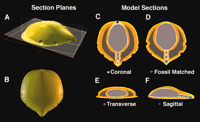
Creationists
are fond of considering the rapid appearance of many
animal phyla in the fossil record of the Cambrian and
claiming that there is no fossil evidence of animals
before the Cambrian.
Here
Chen et al describe a tiny but complex bilaterian (ie
possessing mirror symmetry like many modern animals)
fossil animal dating from a t least 40 million years
before the Cambrian
Chen
et al, Science 305, 218 - 222 (July 2004). Go
here for the abstract
|
| Detailed
Comparison of Chimp Chromosome 22 and Human Chromosome
21

28
May 2004
A
group of scientists known as the International Chimpanzee
Chromosome 22 Consortium have published their detailed
sequence of chimp chromosome 22 and their nucleotide
by nucleotide comparison with the equivalent chromosome
21. They found a surprising degree of difference
in protein coding regions. Highlights include the
fact that 1.44% of nucleotides are different; protein
coding regions have about as much difference as non-coding
genomic regions; 179 out of 231 genes are identical
in length and of these 140 have changes in one or more amino
acid.
International
Chimpanzee Chromosome 22 Consortium, Nature 429, 382 -
388 here
|
| New
hominin species just after human-chimp divergence
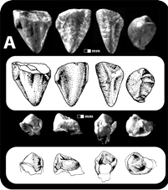
25
March 2004
Haile-Selassie
et al have assessed recent dental fossil discoveries
in the Awash region, and have concluded that Ardipthecus
kadabba is a separate species not a subspecies of A
ramidus which is found nearly a million years later.
A kadabba is the earliest known species after
the human-chimpanzee split.
Haile-Selassie
et al, Late Miocene Teeth from Middle Awash, Ethiopia, and Early Hominid Dental
Evolution, Science 303, 1503 - 1505 (2004)
|
| Oldest
marsupial discovered
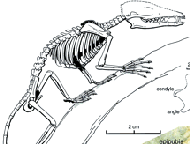
5
January 2004
Luo
and colleagues have announced the discovery of the oldest
fossil in the lineage leading to modern marsupials.
Sinodelphys szalayi is a small tree climbing animal
from the Yixian formation dated to 125 million
years ago. This makes Sinodelphys the same age as the
earliest known placental mammal, Eomaia scansoria,
described last year.
Luo
et al, An Early Cretaceous Tribosphenic Mammal and Metatherian Evolution,
Science 302, 1934 - 1940. The abstract is available
here.
|
| Draft
Chimp Genome published
13
December 2003
The National Human Genome Research Institute (NHGRI), one of the National
Institutes of Health (NIH), today announced the first draft version of the
genome sequence of the chimpanzee and its alignment with the human genome. All
of the data have been deposited into free public databases and are now available
for use by scientists around the world. Go here
for more information.
In
a separate paper, Clark et al, Science 302, 1876 - 1877,
compare chimp and human sequences to find genes that
have undergone rapid change since the divergence of
the two lineages from their common ancestor. By anchoring
the observations with the mouse genome, the authors
are able to determine wether genes are undergoing rapid
evolution in the human or the chimp lineage. Genes
that have undergone rapid evoliution in humans include
those implicated in hearing and smelling. Go here
for an abstract of the paper.
|
| Huge
support for Big Bang Cosmology
10
November 2003
Max
Tegmark and colleagues have just published data for
200,000 galaxies in the Sloan Digital Sky Survey. In
particular they have analysed the measured matter density
power spectrum (the clustering of galaxies). Their analysis
can be used to derive cosmological parameters (much
like the CMB anisotropy spectrum).
The
measured cosmological parameters (such as the age of
the universe) show a very close match between
the entirely different ways of measuring them. Even
more impressive, by combining the two types of data,
very tight constraints can be put on somne of the parameters.
This is extremely strong evidence in favour of
our current cosmology models.
Go
here for the papers::
The
paper describing the spectrum and how it is measured.
The
paper deriving the cosmological parameters
|
| Could
the universe be finite in extent?
9
October 2003
A
report in Nature suggests that the lack of power
in the largest scale aniotropies of the Cosmic Microwave
Background, can be explained by a finite universe with
a dodecahedral topology. Go here for more information

|
| The
fossil of the largst known rodent analysed - 700kg of
rodent
5
October 2003
In
Science, Sánchez-Villagra et al report on the anatomy
of the largest known extinct rodent - ten times heavier
than the largest living rodent, the capybara. Phoberomys
pattersoni comes from the upper Miocene of Venezuela
and weighs in at 700kg or 1400 times that of a guinea
pig. Go here
for the abstract
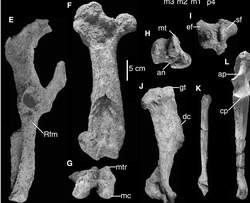
|
| The
role of Hox genes in the evolution of the body plan of
cepahalopods
27
August 2003
Lee
et al report work to investigate the expression of Hox
genes during the development of squid. The squid
form part of the Lophotrochozoa, a clade that displays
more body plan diversity than any other clade of
animals. Their work sheds light on the nature
of te molecular processes which drive morphological
change during evolution

Go
here for the abstract
|
| Y-chromosome
sequenced - male genes maintained by a special mechanism.
20
June 2003
Rozen
et al and Skaletsky et al report the sequencing of the male specific region
of the Y-chromosome (MSY). One important finding is that gene conversion (non-reciprocal
recombination) between the arms of the eight major palindromes in the MSY, appears
to have replaced the process of crossing over which occurs in the autosomes
and the X-chromosome as a mechanism of gene maintenance.
Nature
journal is allowing free access to both
papers and other related material here
|
| New
African human fossils reported: immediate ancestors of modern humans
11
June 2003
White
et al report in Nature the discovery of fossil human crania from
Herto, Middle Awash, Ethiopia, dates at between 150,000 and 164,000 years ago.
These crania probably represent the immediate ancestors of anatomically modern
humans being intermediate between modern humans and more archaic African fossils.
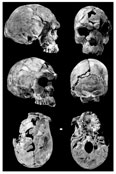
Go
here for the abstract
Go
here for free access to Nature's News and Views
Go
here for Nature Science Update

|
|
Measurements of Big
Bang afterglow confirm cosmological model; see below for
30 May
2003
First year data from the
Wilkinson Microwave Anisotropy Probe confirm key elements of the
cosmological model: a universe expanding at the critical rate, flat space,
13.7 billion years old, 4% matter, 23% dark matter, 73% dark energy. The
observations from WMAP of the fluctuations in the Cosmic Microwave
Background (the afterglow from the Big Bang more than 13 billion years
ago) confirm these predictions. Go here for the
NASA news item and here for the
formal
technical first year reports.

31st
May: Update published by Seife in Science 300, 730 - 731, here
|
| How
do complex features evolve? Modeling shows how
9
May 2003
A
constant refrain of creationists is the claim that evolution cannot explain
complex features. This argument was famously proposed by William Paley
in the 18th century, and has recently been revived by the Intelligent Design
movement in a more sophisticated form, particularly by Michael Behe in his book,
'Darwin's Black Box'. The argument has been refuted, but the argument is constantly
used by creationists and IDers.
Now,
in Nature, Lenski et al show that complex features can evolve. They use
digital
organisms to show that complex features can evolve by co-opting simpler features
and even mildly deleterious mutations.
Go
here for the abstract
|
|
Detailed Review article
on genetics and the evolution of Man
25 April
2003
As part of Nature's
celebration of the 50th anniversary of the discovery of the structure of
DNA, Nature has a detailed review article by Sean Carroll on the
genetic basis for the evolutionary changes in our genome that make
mankind what we are. Carroll identifies the specific morphological
and behavioural attributes that distinguish Homo sapiens from other great
apes and assess the known evolutionary changes in the genome that
contribute to these. Go
here for the abstract
|
|
Gorilla and chimpanzee
numbers plummet - humans nearest relatives in danger
11 April
2003

A study in Nature just
published shows that the numbers of apes in West Africa, the last
stronghold of gorillas and the common chimpanzee have halved in the last
20 years. As the authors say:
'Gorillas
and common chimpanzees should be elevated immediately to 'critically
endangered' status. Without aggressive investments in law enforcement,
protected area management and Ebola prevention, the next decade will see
our closest relatives pushed to the brink of extinction.
Go here for the
abstract
|
| Squirrel
DNA reveals distribution affected by tectonic and sea-level
changes
21
March 2003
In
Science, Mercer and Roth demonstrate that the DNA of
squirrels correlates well with distribution and isolation
based on well known movements of the continents and
rises and falls in sea level, leading to isolation and
integration of populations. Go
here for the abstract
|
|
Oldest human footprints
found
13 March 2003
Nature has a description of the oldest
human footprints ever found.
Formed in volcanic ash, these
footprints are fully bipedal and date
to 350,000 years ago
Go
here for the
abstract
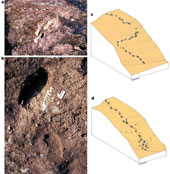
|
| Big
Bang cosmology questioned
17
March 2003
Lieu
and Hillman find in Astrophysical Journal Letters,
that the propagation of light does not depend on quantisation
of time. In simple terms, this means
that they observe time as smooth, not divided into discrete
but tiny parcels. If confirmed, this leads to
a problem for the Big Bang cosmology which, up to now,
has relied on quantum uncertainty to blur out the universe
at the Big Bang and avoid a singularity at the
beginning. Go
here for the abstract
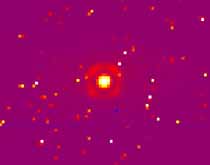
|
|
Homo erectus calvarium found in
Java
10 March 2003
In Science, Baba et al report finding
a Homo erectus calvarium with intact
(and surprisingly modern) cranial
base.
Go
here for the
abstract
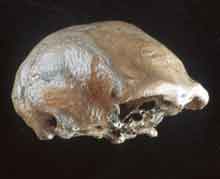 |
|
|
New finds in Olduvai call Homo
rudolfensis into
question
21 February 2003
In Science, Blumenschine et al find a
human mandible in Olduvai west that is
similar to Kenyan KNMER
1470.
Go here for the
abstract

|
|
All
carnivores in Madagascar have a common
ancestor
13
February 2003
In
Nature, Yoder et al show that
all the carnivores on Madagascar arose
from a common ancestor.
Go here
for the abstract
|
|
Four-winged
Dinosaurs from China
23
January 2003
Discovery
of fossils of
four-winged
dinosaurs (dromaeosaurs) with
evidence of wing structures on all
four limbs
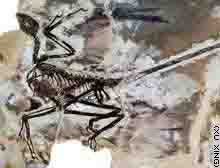
|

